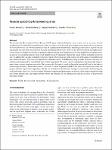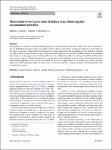Search
Author
- Jorgensen, Ed (3)
- McFadyen, Ron (3)
- Nora, El-Rashidy (3)
- Christian, Homeyer (2)
- next >
Subject
- programming (10)
- Open Access (8)
- Java (7)
- Programming (7)
- next >
Date issued
- 2020 - 2025 (293)
- 2010 - 2019 (39)
- 2000 - 2009 (2)
- 1999 - 1999 (1)
Has File(s)
- true (335)
Search Results
Prediction and classification of diseases are essential in medical science, as it attempts to immune the spread of the disease and discover the infected regions from the early stages. Machine learning (ML) approaches are commonly used for predicting and classifying diseases that are precisely utilized as an efficient tool for doctors and specialists. This paper proposes a prediction framework based on ML approaches to predict Hepatitis C Virus among healthcare workers in Egypt. We utilized real-world data from the National Liver Institute, founded at Menoufiya University (Menoufiya, Egypt). The collected dataset consists of 859 patients with 12 different features. To ensure the robustness and reliability of the proposed framework, we performed two scenarios: the first without featur... |
We introduce the R everse S patial Top-k K eyword (RSK) query, which is defined as: given a query term q, an integer k and a neighborhood size find all the neighborhoods of that size where q is in the top-k most frequent terms among the social posts in those neighborhoods. An obvious approach would be to partition the dataset with a uniform grid structure of a given cell size and identify the cells where this term is in the top-k most frequent keywords. However, this answer would be incomplete since it only checks for neighborhoods that are perfectly aligned with the grid. Furthermore, for every neighborhood (square) that is an answer, we can define infinitely more result neighborhoods by minimally shifting the square without including more posts in it. To address that, we need to i... |
Cryptographic constructions based on hard lattice problems have emerged as a front runner for the standardization of post-quantum public-key cryptography. As the standardization process takes place, optimizing specific parts of proposed schemes, e.g., Bernoulli sampling and integer Gaussian sampling, becomes a worthwhile endeavor. In this work, we propose a novel Bernoulli sampler based on polar codes, dubbed “polar sampler”. The polar sampler is information theoretically optimum in the sense that the number of uniformly random bits it consumes approaches the entropy bound asymptotically. |
Iterative stencil computations are widely used in numerical simulations. They present a high degree of parallelism, high locality and mostly-coalesced memory access patterns. Therefore, GPUs are good candidates to speed up their computation. However, the development of stencil programs that can work with huge grids in distributed systems with multiple GPUs is not straightforward, since it requires solving problems related to the partition of the grid across nodes and devices, and the synchronization and data movement across remote GPUs. In this work, we present EPSILOD, a high-productivity parallel programming skeleton for iterative stencil computations on distributed multi-GPUs, of the same or different vendors that supports any type of n-dimensional geometric stencils of any order... |
Motion Estimation is one of the main tasks behind any video encoder. It is a computationally costly task; therefore, it is usually delegated to specific or reconfigurable hardware, such as FPGAs. Over the years, multiple FPGA implementations have been developed, mainly using hardware description languages such as Verilog or VHDL. Since programming using hardware description languages is a complex task, it is desirable to use higher-level languages to develop FPGA applications.The aim of this work is to evaluate OpenCL, in terms of expressiveness, as a tool for developing this kind of FPGA applications. To do so, we present and evaluate a parallel implementation of the Block Matching Motion Estimation process using OpenCL for Intel FPGAs, usable and tested on an Intel Stratix 10 FPGA... |
The perception of realism in computer-generated images can be significantly enhanced by subtle visual cues. Among those, one can highlight the presence of dust on synthetic objects, which is often subject to temporal variations in real settings. In this paper, we present a framework for the generation of textures representing the accumulation of this ubiquitous material over time in indoor settings. It employs a physically inspired approach to portray the effects of different levels of accumulated dust roughness on the appearance of substrate surfaces and to modulate these effects according to the different illumination and viewing geometries. The development of its core algorithms was guided by empirical insights and data obtained from observational experiments which are also descr... |
In this work, we study resolvent splitting algorithms for solving composite monotone inclusion problems. The objective of these general problems is finding a zero in the sum of maximally monotone operators composed with linear operators. Our main contribution is establishing the first primal-dual splitting algorithm for composite monotone inclusions with minimal lifting. Specifically, the proposed scheme reduces the dimension of the product space where the underlying fixed point operator is defined, in comparison to other algorithms, without requiring additional evaluations of the resolvent operators. We prove the convergence of this new algorithm and analyze its performance in a problem arising in image deblurring and denoising. |
Incorporating machine learning into automatic performance analysis and tuning tools is a promising path to tackle the increasing heterogeneity of current HPC applications. However, this introduces the need for generating balanced datasets of parallel applications’ executions and for dealing with natural imbalances for optimizing performance parameters. This work proposes a holistic approach that integrates a methodology for building balanced datasets of OpenMP code-region patterns and a way to use such datasets for tuning performance parameters. The methodology uses hardware performance counters to characterize the execution of a given region and correlation analysis to determine whether it covers an unique part of the pattern input space. |
Bipartite secret sharing schemes realize access structures in which the participants are divided into two parts, and all the participants in the same part play an equivalent role. Such a bipartite structure can be described by the collection of its minimal points. The complexity of a scheme is the ratio between the maximum share size given to the participants and the secret size, and the Shannon complexity of a structure is the best lower bound provided by the entropy method. Within this work, we compute the Shannon complexity of regular bipartite structures and provide optimal constructions for some bipartite structures defined by 2 and 3 points. |
In this paper, techniques for dynamic load balancing of the cellular automata parallel execution are presented for the case of domain space partitioned along two dimensions. Starting from general closed-form expressions that allow to compute the optimal workload assignment in a dynamic fashion when partitioning takes place along only one dimension, we tailor the procedure to allow partitioning and balancing along both dimensions. Both qualitative and quantitative experiments are carried out that assess performance improvement in applying load balancing for the case of two-dimensional partitioned domain, especially when the load balancing takes place along both dimensions. |










